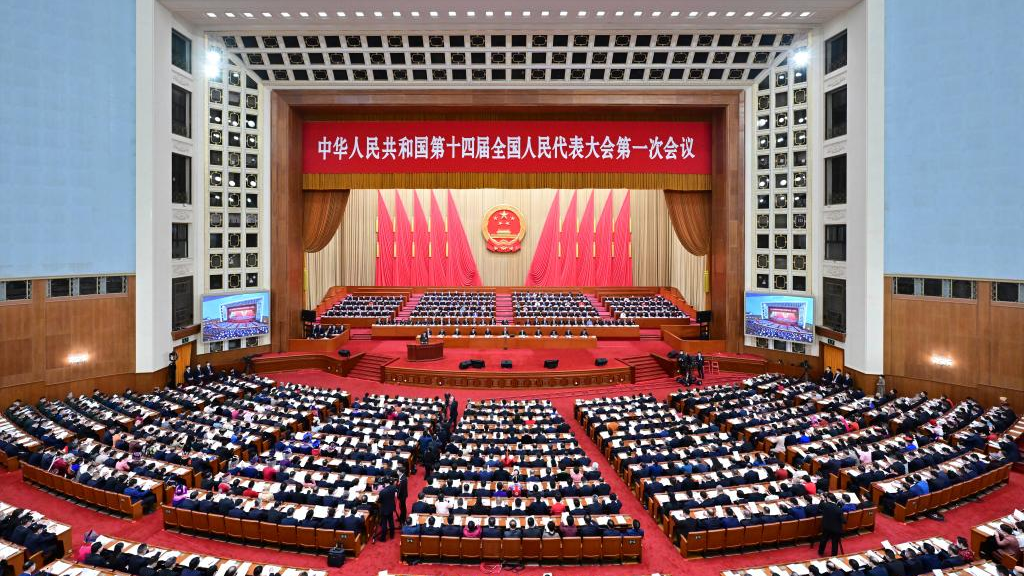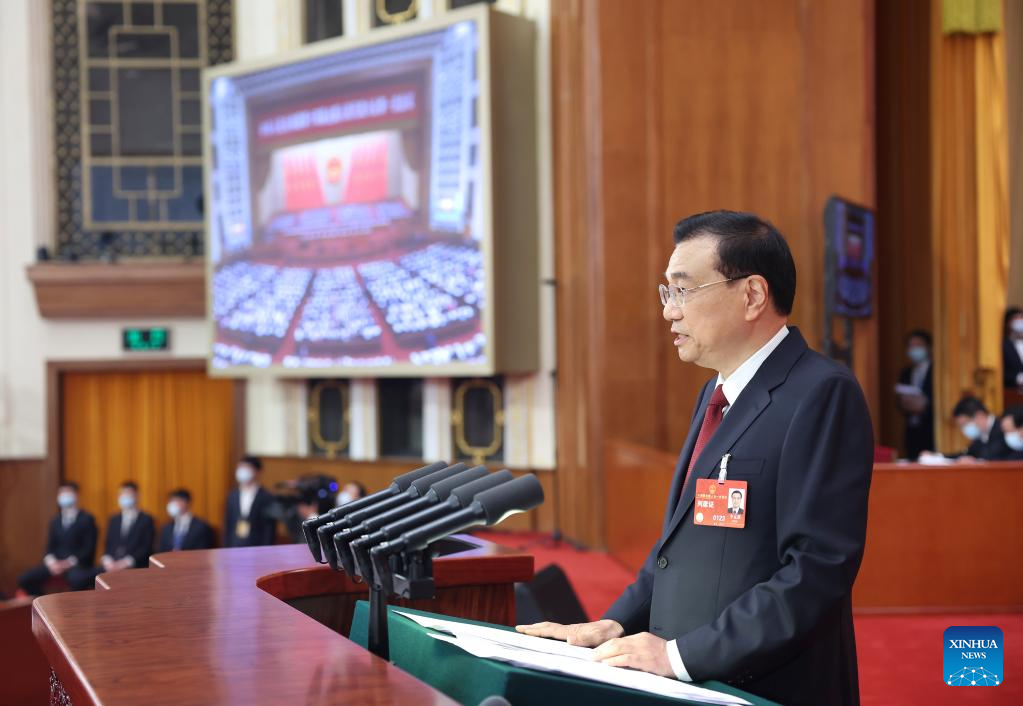
The opening meeting of the first session of the 14th National People's Congress (NPC) is held at the Great Hall of the People in Beijing, capital of China, March 5, 2023. /Xinhua
The opening meeting of the first session of the 14th National People's Congress (NPC) is held at the Great Hall of the People in Beijing, capital of China, March 5, 2023. /Xinhua
Editor's note: Qian Feng is a senior research fellow at the National Strategic Institute, Tsinghua University and Taihe Institute. The article reflects the author's opinions and not necessarily those of CGTN.
On March 5, Chinese Premier Li Keqiang delivered a government work report at the opening meeting of the first session of the 14th National People's Congress in Beijing. Against the backdrop of a looming global recession and China's clear economic recovery, what is most eye-catching is the level at which the Chinese government work report sets the targets of economic development. This is an important reference for predicting the performance of China's economy throughout the whole year, and to a large extent determines the direction, intensity and mode of macro-policy control.
In the government work report, Premier Li proposed that the main development targets for 2023 are: GDP growth of around 5 percent, about 12 million new urban jobs, surveyed urban unemployment rate of around 5.5 percent, and consumer price index (CPI) increase of about 3 percent; and personal income growth basically coinciding with national economic growth.
Based on the previous setting of national economic growth targets between 5.5 percent and 6.5 percent, and the target of major economic provinces above 5 percent, the mainstream view is that under the influence of COVID-19 pandemic in 2020 and 2021, China's economic compound growth would be 5.1 percent. If also taking into account factors such as the severely impacted global industrial chain, China setting its GDP growth target at around 5 percent is reasonable and reflects the pragmatic attitude of the Chinese government.
This not only provides a frame of reference for employment, prices and economic policies, but also helps to improve social expectations and boost market confidence. It also leaves ample room for some risks and uncertainties that economic growth will continue to face in the future.

Chinese Premier Li Keqiang delivers a government work report at the opening meeting of the first session of the 14th National People's Congress (NPC) at the Great Hall of the People in Beijing, capital of China, March 5, 2023. /Xinhua
Chinese Premier Li Keqiang delivers a government work report at the opening meeting of the first session of the 14th National People's Congress (NPC) at the Great Hall of the People in Beijing, capital of China, March 5, 2023. /Xinhua
Looking back at 2022, due to internal and external factors such as the pandemic and the global economic downturn, China's economic year-on-year growth rate was 3 percent, failing to meet the target set at the beginning of the year. However, it is not easy to achieve such growth in an unusually severe situation. In particular, with the optimization of COVID-19 response policies at the end of last year, China's strong industrial production and consumption performance in December 2022 and the year-on-year growth rate of 2.9 percent in the fourth quarter all exceeded market expectations, showing the strong resilience of the Chinese economy.
Since the beginning of 2023, China's economy has shown vigorous momentum. The central government and local governments have introduced policies in terms of fiscal, financial, investment, consumption, and business environment, sending a strong signal of steady economic growth. Economic data released recently also show that China's economy is experiencing steady recovery.
In terms of leading indicators, China's manufacturing purchasing managers' index in February, released by the National Bureau of Statistics on March 1, was 52.6 percent, up 2.5 percentage points from the previous month, rising significantly for two consecutive months and hitting a new high since May 2012.
Most international institutions are also generally optimistic about China's economic growth this year, repeatedly raising their economic growth forecasts. The International Monetary Fund, for example, has sharply raised its forecast for Chinese economic growth this year to 5.2 percent. Nomura Securities rose to 5.3 percent from 4.8 percent, Goldman Sachs Group Inc. to 5.5 percent from 4.5 percent, and Morgan Stanley, holding the most optimistic view, even expects China's economy to grow by 5.7 percent.
It has been pointed out in the government work report that the past five years have been extremely unusual and extraordinary. China has withstood multiple tests, such as the accelerating evolution of the changing world, the impact of the COVID-19 pandemic, and the domestic economic downturn. China has achieved the First Centenary Goal of building a moderately prosperous society in all respects, and embarked on its journey to the Second Centenary Goal of building a great modern socialist country in all respects by the middle of this century.
In the long run, the fundamentals of China's economy have not changed. There is every reason to believe that if the opportunity seized to deepen economic restructuring and consolidate the foundation for high-quality development, 2023 will be the year for the Chinese economy to return to the track of normal operation.
(If you want to contribute and have specific expertise, please contact us at opinions@cgtn.com. Follow @thouse_opinions on Twitter to discover the latest commentaries in the CGTN Opinion Section.)